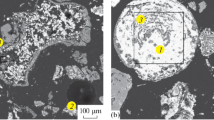Abstract
The solid-phase carbothermic reduction of metals in the crystal lattice of ferrichrompicotite from massive chromium ore is experimentally studied. The reduction is found to develop according to an electrochemical mechanism. The metals precipitate both on the surface and in the volume of an ore grain. The electron transfer from a reducing agent to cations takes place through anion vacancies, which form during the interaction of the reducing agent with an oxide. An iron-chromium metallic alloy is the primary product of reduction, and iron and chromium are reduced simultaneously but at different and variable rates, which depend on their concentrations in a local oxide volume. The formation of carbides on the surface of an ore grain as a result of the interaction of the reduced metals with carbon causes the metal atom flux from the volume to the surface of the grain, the appearance of cation vacancies in the oxide, the dissolution of the metallic phase, and the termination of reduction. The decomposition of silicon carbides with the formation of silicocarbides restores the extraction of oxygen anions from the oxide lattice, which facilitates the resumption of reduction.
Similar content being viewed by others
References
V. P. Chernobrovin, I. Yu. Pashkeev, G. G. Mikhailov, et al., Theoretical Foundations of the Production of Carbon-Containing Ferrochrome from Ural Oresh (YuUrGU, Chelyabinsk, 2004).
M. I. Gasik and N. P. Lyakishev, Metallurgy of Chromium (Eliz, Moscow, 1999).
V. I. Grinenko, O. I. Polyakov, M. I. Gasik, et al., Chromium of Kazakhstan (Metallurgiya, Moscow, 2001).
V. E. Roshchin, N. V. Mal’kov, A. V. Roshchin, and A. V. Rechkalova, “Solid-phase chromium reduction from poor chrome iron ores,” Elektrometallurgiya, No. 11, 22–30 (1999).
V. E. Roshchin, A. V. Roshchin, and N. V. Mal’kov, “Electrochemical mechanism of pyrometallurgical reduction of disseminated chrome iron ores,” Elektrometallurgiya, No. 6, 38–44 (2000).
A. V. Roshin, V. E. Roshin, A. G. Ryabukhin, and Yu. N. Goikhenberg, “Role of the silicate phase of an enclosing rock in the prereduction of disseminated chromium ores,” Russian Metallurgy (Metally), No. 4, 261–267 (2007).
A. V. Roshchin and V. E. Roshchin, “Physical aspects of the solid-phase reduction of metals,” Elektrometallurgiya, No. 1, 13–22 (2009).
V. E. Roshchin and A. V. Roshchin, “Selective reduction of metals in the lattice of a complex oxide,” Russian Metallurgy (Metally), No. 3, 185–193 (2013).
V. P. Sazonov, “Chromium in the hydrothermal process,” in Proceedings of Ural Summer Mineralogical School, Yekaterinburg (UGTTA, Yekaterinburg, 1997), pp. 81–86.
A. I. Sizykh and V. A. Bulanov, “Geochemistry of chromium in rock-forming minerals,” in Proceedings of Ural Summer Mineralogical School, Yekaterinburg (UGTTA, Yekaterinburg, 1997), pp. 87–89.
K. Pederson, “Non-stoichiometric magnesium spinels in shale xonoliths from a native iron-bearing andesite at Asuk, Disko, central West Greenland,” Contribut. Miner. Petrol. 67, 331–340 (1978).
A. V. Roshchin and V. E. Roshchin, “Diffusion of anions and cations in oxide crystal lattices during the reduction and oxidation of metals,” Russian Metallurgy (Metally), No. 1, 1–5 (2003).
A. V. Roshchin and V. E. Roshchin, “Electrical conduction and lattice disordering in oxides upon the reduction and oxidation of metals,” Russian Metallurgy (Metally), No. 2, 97–102 (2003).
K. L. Kosyrev and S. E. Olsen, “Silicon and carbon in conductor alloys,” INFACON VII, 329–338 (1995).
N. P. Lyakishev and N. P. Gasik, Physical Chemistry and Technology of Electroferroalloys (ELIZ, Moscow, 2005).
Author information
Authors and Affiliations
Corresponding author
Additional information
Original Russian Text © V.E. Roshchin, A.V. Roshchin, K.T. Akhmetov, 2014, published in Metally, 2014, No. 2, pp. 3–9.
Rights and permissions
About this article
Cite this article
Roshchin, V.E., Roshchin, A.V. & Akhmetov, K.T. Mechanism and sequence of the metal reduction in the lattice of chromospinelides. Russ. Metall. 2014, 173–178 (2014). https://doi.org/10.1134/S0036029514030021
Received:
Published:
Issue Date:
DOI: https://doi.org/10.1134/S0036029514030021




